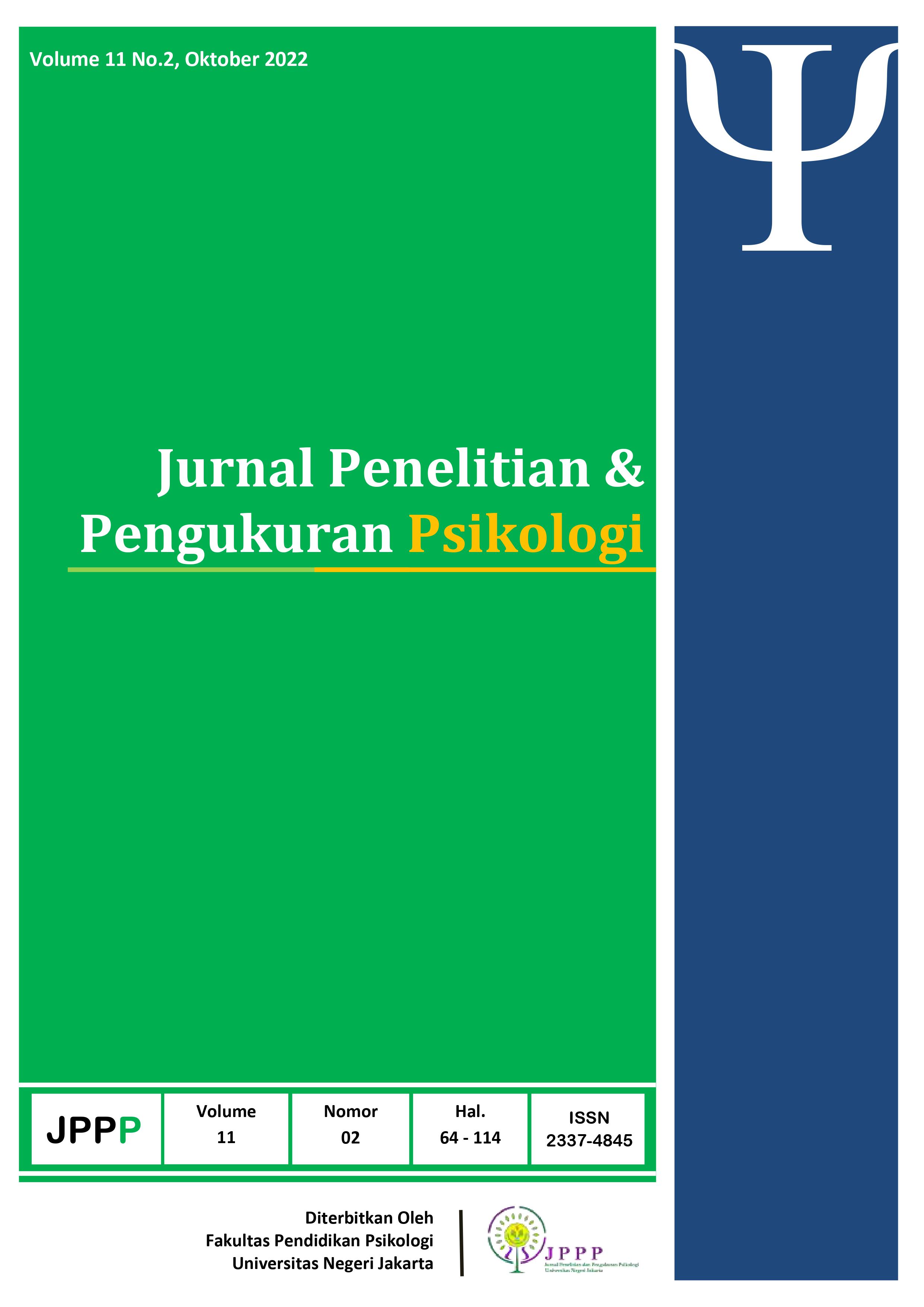Gambaran Tingkat Intelegensi Non-Verbal Siswa Tuna Rungu SLB B di Purwokerto
DOI:
https://doi.org/10.21009/JPPP.112.07Keywords:
Bender-Gestalt, CPM, Deaf Child, IntelligenceAbstract
Intelligence is a measure of student intelligence, when students have high intelligence, there is good learning. Intelligence in deaf students is very difficult to measure because most of the measuring instruments used use verbal functions, on the other hand many SLB B teachers complain that their students experience academic decline. This happens because most teachers do not know the intelligence of their students so that teachers give treatment with the same portion when learning takes place. The purpose of this study is to provide an overview of the intelligence of deaf students at SLB B Purwokerto. The data collection method used was the saturated sample technique so that 30 participants were obtained. Based on the results of the criterion validity test, it was obtained that r = 0.465 so that the cpm test and the bender-gestalt test were declared valid. The results of the CPM test reliability test (α cronbach = 0.889) on the Bender-Gestalt test (α cronbach = 0.789). The correlation test showed that there was a significant correlation between the cpm test and the bender-gestalt test. In the CPM test, the non-verbal reasoning grade on deaf students is in group IV below average intellectual capacity and students with superior grade I are male.
References
Azwar, S. (1996). Pengantar Psikologi Intelegensi (I). Pustaka Pelajar.
Azwar, S. (2016). Konstruksi Tes Kemampuan Kognitif (I). Pustaka Pelajar.
Bildiren, A. (2017). Reliability and Validity Study for the Coloured Progressive Matrices Test between the Ages of 3-9 for Determining Gifted Children in the Pre-School Period. Journal of Education and Training Studies, 5(11), 13. https://doi.org/10.11114/jets.v5i11.2599
Dalyono, M. (2005). Psikologi Pendidikan. Rineka Cipta.
Eko Suryadi, M. D. (2021). Korelasi Pola Asuh Otoritatif Terhadap Kecerdasan Interpersonal Anak Tunarungu. Jurnal ORTOPEDAGOGIA, 7(2), 74. https://doi.org/10.17977/um031v7i22021p74-79
Gregory, S. (1976). The Deaf Child and His Family. George Allen & Uniwin Ltd 1976.
Haliza, N., Kuntarto, E., & Kusmana, A. (2020). Pemerolehan bahasa anak berkebutuhan khusus (tunarungu) dalam memahami bahasa. Jurnal Genre (Bahasa, Sastra, Dan Pembelajarannya), 2(1), 5–11. https://doi.org/10.26555/jg.v2i1.2051
Kaplan, R., & Saccuzo, D. (2013). Psychological testing: principles, applications, and issues (8th ed.). Belmont, CA : Thomson Wadsworth.
Kazem, A. M., Alzubiadi, A. S., Yousif, Y. H., Aljamali, F. A., Al-Mashhdany, S. I., Alkharusi, H. A., Al-Busaidi, O. B., Alsarmi, A. M., Al-Bulushi, S. S., Al-Bahrani, W. A., & Al-Fori, S. M. (2007). Psychometric properties of Raven’s Colored progressive matrices for Omani children AGED 5 through 11 years. Social Behavior and Personality, 35(10), 1385–1398. https://doi.org/10.2224/sbp.2007.35.10.1385
Kementrian Sosial, I. (2021). Sistem Informasi Management Penyandang Disabilitas.
Mangunsong, F. (2009). Psikologi Anak Berkebutuhan Khusus (1st ed.). Lembaga Perkembangan Sarana Pengukuran dan Pendidikan Psikologi (LPSP3) Fakultas Psikologi Universitas Indonesia.
Mariyati, L. I. (2019). Inteligensi Dan Kesiapan Anak Masuk Sekolah Dasar. Psyche:Jurnal Psikolog, 1–12.
Meyer, M. (1904). The Proof and Measurement of Association between Two Things. Psychological Bulletin, 1(10), 363–363. https://doi.org/10.1037/h0065390
Nur’aeni, (2016). pendidikan anak berkebutuhan khusus ( arifin suryo Nugroho (ed.)). Universitas Muhammadiyah (UM) Purwokerto Press.
Nuraeni, T., & Mardiah, L. N. (2020). Bagaimanakah Proses Belajar Anak Tunarungu Dan Anak Autisme?: Studi Kasus Di Salah Satu Slb Di Indramayu. Gema Wiralodra, 11(1), 133–142. https://doi.org/10.31943/gemawiralodra.v11i1.115
Nurussakinah Daulay. (2014). Implementasi Tes Psikologi Dalam Bidang Pendidikan. Jurnal Tarbiyah, 21(2), 402–421.
Pincer, R., & Paterson, D. G. (1915). The Binet scale and the deaf children. Journal of Educational Psychology, 6(4), 201–210. https://doi.org/10.1037/h0075610
Prawitasari, J. E., Suwarsiyah, A., Kuwato, T., & Pengantar, I. (2016). Validitas Tes Spm Sebagai Alat Pengukur Kecerdasan Pelajar-Pelajar Sma. Jurnal Psikologi UGM, 4(1), 40–57.
Rahmah, F. N. (2018). Problematika Anak Tunarungu Dan Cara Mengatasinya. Quality, 6(1), 1. https://doi.org/10.21043/quality.v6i1.5744
Suralaga, F. (2020). Psikologi Pendidikan : Implikasi dalam Pembelajaran (Solicha (ed.); 1st ed.). PT. Rajagrafindo Persada.
Suwartono, C., Amiseso, C. P., & Handoyo, R. T. (2017). Uji Reliabilitas dan Validitas Eksternal The Raven’s Standard Progressive Matrices. Humanitas, 14(1), 1. https://doi.org/10.26555/humanitas.v14i1.5772
Suzianti, A., & Atthousi, H. N. (2019). Implementation of design thinking approach in designing learning support tools in the classroom for hearing impaired person (case study: Elementary school students in SLB-B Santi Rama). ACM International Conference Proceeding Series, 75–80. https://doi.org/10.1145/3332324.3332338
Tarigan, M., & Fadillah, F. (2021). Analisis Item Response Theory Raven’s Coloured Progressive Matrices pada Sampel Anak Usia Dini. Psikodimensia, 20(2), 158–169. https://doi.org/10.24167/psidim.v20i2.3101
Vernon, M. (2005). Fifty years of research on the in telligence of deaf and hard-of-hearing children: A review of literature and discussion of implications. Journal of Deaf Studies and Deaf Education, 10(3), 225–231. https://doi.org/10.1093/deafed/eni024
Widayanti, C. G., & Rusmawati, D. (2012). Profil Intelegensi Pada Siswa dengan Kesulitan Belajar di Sd Negeri Gisikdrono Semarang. 1–10.
Wulandari, A. A., Dafik, D., & Susanto, S. (2014). Penerapan Pembelajaran Matematika Realistik dengan Whole Brain Teaching pada Pokok Bahasan Teorema Pythagoras untuk Meningkatkan Hasil Belajar dan Aktivitas Siswa Tunarungu Kelas VIIIB SMPLB Sinar Harapan Probolinggo Tahun Ajaran 2014/2015. Jurnal Edukasi Unej, 20, 40–46. https://jurnal.unej.ac.id/index.php/JEUJ/article/view/1400/1147
Zaitun. (2017). Pendidikan Anak Berkebutuhan Khusus. Kreasi Edukasi.







